Every business wants to succeed and set a milestone in its respective industry. The goal is to create unique products never seen before in the market that are indispensable to the public, and therefore they cannot resist buying them. However, creating and launching new products, especially when they are more complex (software, technology), demands the highest level of collaboration and efficiency from the product teams and their leaders.
Fortunately, there are advanced tools called product management software that help product managers to minimize inefficiencies, errors, and communication gaps. Today we present the 9 Best Product Management Tools In 2023. Let’s do it!
What Is Product Management Software?
Product management software is an informatics solution that helps product teams execute all the stages of the product lifecycle efficiently. They combine powerful tools to get a better business plan based on market research, brand coherence, and customer needs. Then, you can prioritize and assign tasks to reduce time and cost with a proactive workflow.
“The top 3 challenges for product managers are competing objectives in the organization (56,4%), lack time (50,8%) and lack of role clarity (35,0%).”
That is why product teams use product management tools to carry out tasks and activities when developing a new product. Such as prototyping, designing, user research, customer feedback, process roadmap, key features prioritization, data analysis, budget, and release timeline.
They are crucial, especially when working with remote teams; you need unified and centralized platforms. These tools allow you to gather all process data and interactions in one place to achieve more control and visibility over your activities. More important, you can work hand in hand and boost team collaboration.
Who Uses Product Management Software?
These tools are ideal for new model businesses focused on creating complex and high-performance products, such as software, apps, tech developers, b2b companies, etc. They must aim to make their products better meet the needs of their audience and not quickly become outdated. Also, managers and product team leaders must collaborate and synchronize their activities to execute business strategies in less time and cost.
Engineering teams must keep up to date with changes and variations in the budget and time to launch. In addition, executives of new business models use them to track the progress of all teams and measure investment risk and future expectations. Sadly, only 60.3% of executive leaders partially understand the value a product manager brings to their business.
What are the main benefits of using product management software?
- Product managers can synchronize the teams’ work with your business’s objectives.
- They show the resources available such as user research and behavior, to meet market demands.
- They analyze the investment risk at each production stage and the probability of return on investment.
- Finally, they offer more significant control and visibility in creating a process to refine your business strategies and their consequent execution.
What is the Best Product Management Software?
This is a frequently asked question I get from small business owners who are just starting out, and the truth is that it’s not such a simple decision. I can’t tell you to choose one or the other. Why? The truth is that you must consider what the key features for you are. I recommend you look for the ultimate product management software that offers:
- An authentic user experience and focus on creating new product models.
- Have meeting recording tools, so you don’t lose any ideas.
- Create roadmaps for product strategy.
- Facilitate task management and assignment of activities to each team.
- Product managers simplify the process of researching user needs.
- Centralize your product teams’ communication bridges.
- Measure users’ performance and progress.
- Collect every single input on the new prototype.
My top 9 choices for the best product management platforms
1. Monday

Monday’s product management software is an intelligent business tool that can adapt and provide optimal performance response for medium to large-sized businesses in any industry. My experience with this tool is quite pleasant when devising and planning more complex products. This is because as I integrate new members, plan new activities and organize tasks, the system maintains a harmonious and efficient product lifecycle, with all teams in sync.
Features:
- 1000 Gb storage
- Timelines and activity log up to 5 years, in Gantt format with a customer focus.
- Workflow tracking in Kanban boards.
- Monday product managers integrate with communication tools such as Zoom
- Different types of views (calendar, maps, guest dashboards, and more)
- Project management includes task assignments, the workload of each member, and time spent.
- Create custom dashboards to avoid delays.
- Integration with Android and iOs apps.
- Customized forms to improve feedback with customers.
Advantages:
- Monday is one of the best product management tools that are easy to use. Just enter your email address.
- The dashboards are dynamic, intuitive, easy to understand, and can be created in minutes.
- Each view offers you commenting options for specific items.
- Integrates with different tools Google Calendar, Drive, Slack, Jira, Stripe, and many more.
Disadvantages:
- The product management tool does not have a free plan.
- Integration actions are limited in the first two plans.
- It is designed for businesses with large work teams.
Pricing:
- Starting price: $27 per month.
- Trial Period: 14 days
Plan your products from start to finish!
2. ClickUp
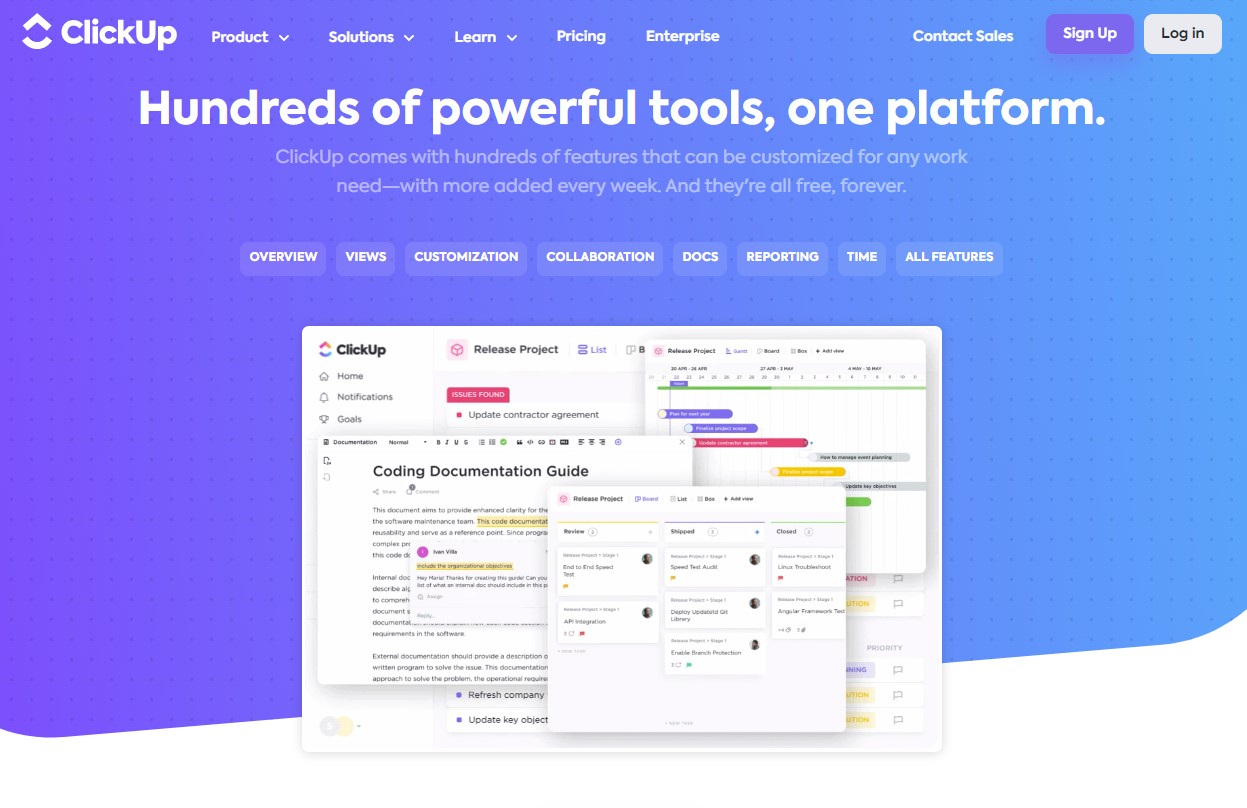
ClickUp is one of the best product lifecycle management software that is very useful if you have a business or freelancer. One of my favorite options for its value for money, it makes your organization go from zero to 100 in a short time. What makes it unique? I like its complete organization system with task cards, labels by colors, and calendars with reminders, for more optimal project management planning.
Features:
- The best product management tools to create “to-do” lists
- Facilitates the creation of complex products
- Creates easy-to-understand spreadsheets
- Has integrated chat and email to capture ideas.
- Schedules events, reminders, and alerts.
- Enables tracking of objectives
- Its user tracking shows the time per activity
- The product management tool allows recording and taking screenshots.
- Includes a resource manager.
Advantages:
- The product managers offer three levels of configuration according to your needs.
- Extensive integration with other tools
- Its worksheets are clean with colorful tabs
- Free lifetime plan.
Disadvantages:
- Raises its cost when you integrate new tools.
- Its advanced setup can overwhelm beginners.
Pricing:
- Starting price: $5 per month
- Free plan: forever
Step up your productivity!
3. Infinity

Infinity is a cloud-based business solution that ranks third in this product management software comparison. It provides an incredibly flexible platform that allows us to make the product creation cycle focused on the needs of our business and, better yet, our customers. If you have a small, medium, or large-scale business, be it marketing, software development, freelancer, or a startup where you need to plan different products for different audiences, this is an option you should consider.
Features:
- Its task management plans, schedules, and coordinates the development of new prototypes.
- Product managers Order, prioritize and add notes and user interactions at each stage of product creation.
- Assign tasks, and manage budgets and resources to create a product strategy that you can stick to.
- Features different team synchronization tools, such as chats, emails, notifications and alerts, data sharing, and more.
- Create reports to track product teams’ progress and time estimates.
- Present activities on Kanban boards and Gantt timelines for project management.
Advantages:
- It has an attractive one-time fee price.
- Offers multiple customization options to create any view or configuration.
- One of the best product management tools as it is compatible with Microsoft, Android, and iOs.
- In addition, it links directly to the cloud for efficient tracking of your devices.
Disadvantages:
- Some tasks are limited to the primary user of the account.
- For example, automatic subtask creation is limited in the product management tool.
Pricing:
- Starting price: $299 one-time payment
- Trial period: 30 days
Get infinity possibilities!
4. Airfocus
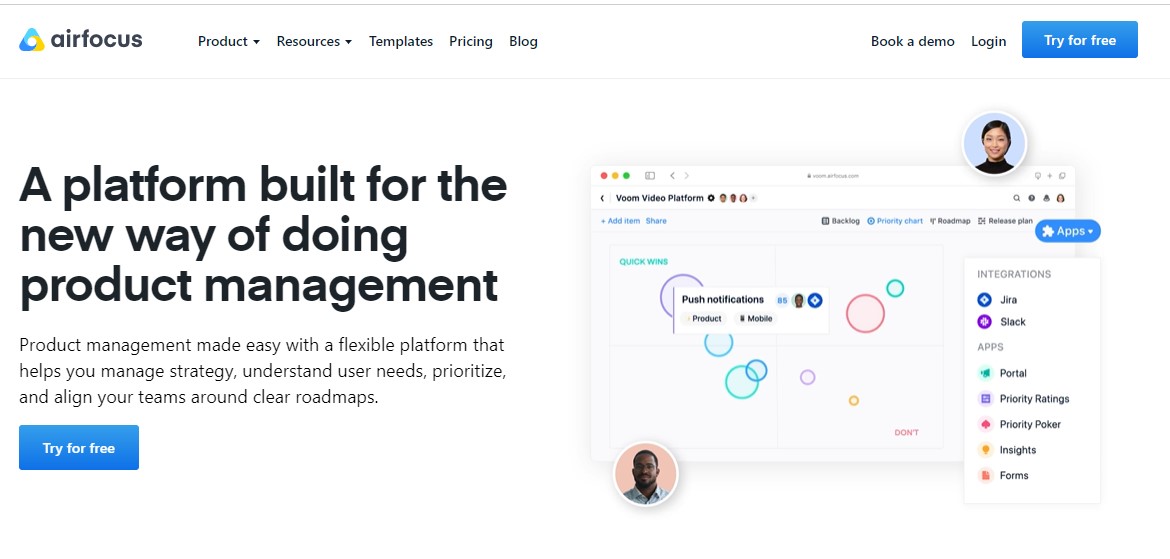
Airfocus is the best product management tool in our count, and that’s because it offers a set of powerful and intuitive work tools to avoid those dreaded bottlenecks. For example, “37.9% of product managers say their backlog is a jumble”, so I like how it gathers and shows data, especially “what if” scenarios, to foresee changes and make life easier. Something vital to keep in mind when creating your Airfocus workspace is what are you going to plan? As it values items and prioritizes them for efficient achievement of your goals.
Features:
- The modular product management platform divides into items, charts, boards, and a timeline.
- The product managers automatically sort items by priority.
- Its prioritize features calculate “priority” based on the value and cost of each task.
- Offers drag and drop Kanban board view, where you can add and remove columns.
- Offers a time-ordered view, to which you can include different tags to measure the progress of each team.
- Includes a budget predictor and a change manager.
Advantages:
- The product management tools show all possible scenarios in your project by adding and removing variables.
- Various templates you can customize to plan your activities.
- Establishes the agile methodology of project management to synchronize multiple teams.
- Includes risk management so you can make the best decisions.
Disadvantages:
- Some product manager options are only available for pro and enterprise plans.
- Airfocus product managers can be overwhelming if you haven’t used similar tools.
Pricing:
- Starting price: $15 per editor per month
- Trial period: 14 days
Let’s build great products!
5. Userpilot
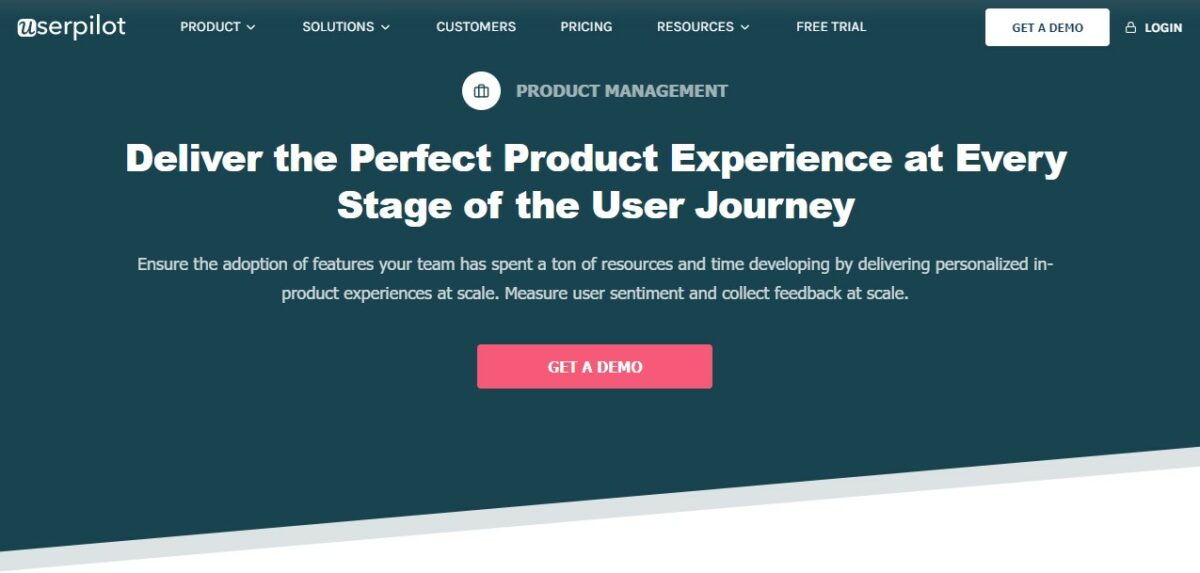
Userpilot is a new product management software option, offering one of the most intuitive user interfaces on the market. So, what sets it apart from other similar tools? Its automatic triggers uniquely measure customer behavior to create a final product by and for them. I recommend you look at this tool because it allows you to classify your team members based on activity. The platform offers them recommendations and tutorials to facilitate the execution of such activities.
Features:
- Product managers identify, track, and segment users.
- Complete segmentation of activities, goals, and progress of the creation process.
- Includes more than 25 activity tagging functions.
- Features a resource management center to fit your budget.
- Create and send surveys based on your customer type.
- Issue participation reports and a weekly progress summary in any language to know about user behavior.
- API access, live chat, phone support, and more.
Advantages:
- You can create custom environments to measure product impact before production.
- For example, conduct customer experience tests and measure customer engagement.
- In addition, create surveys to measure customer satisfaction.
- Integrates quickly with other tools such as Google Analytics.
Disadvantages:
- The product management tool does not have a free version
- It is a tool that requires much more than just clicking; it needs some dedication to make it all work.
- Its prices are not that affordable.
Pricing:
- Starting price: $249 per month
- Trial period: 14 days
Achieve a perfect product experience!
6. Productboard
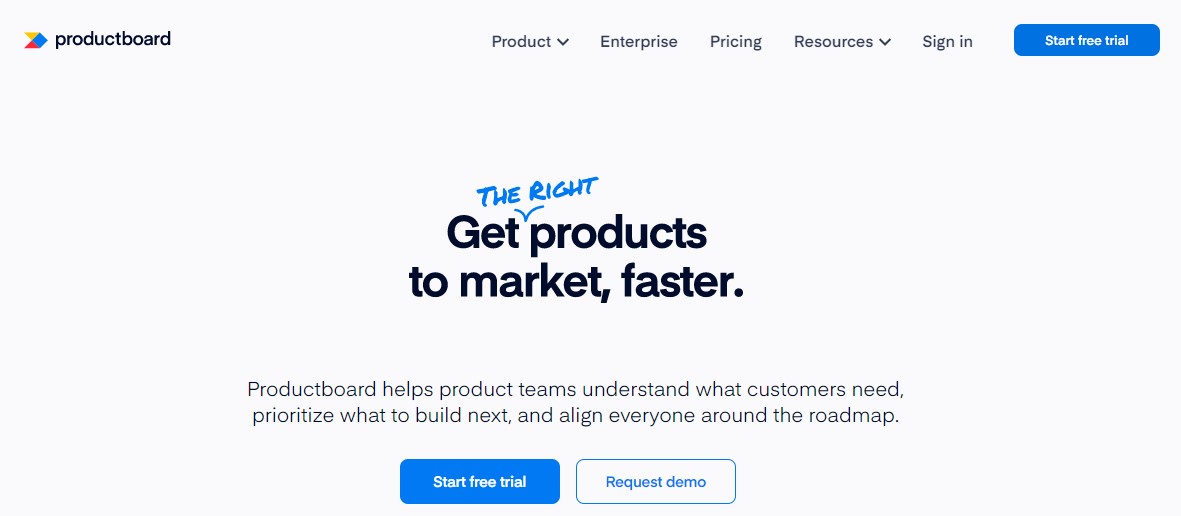
Productboard is one of the product management software tools you should consider if you are looking for one that allows you to fully understand user behavior and problems and devise the best way to solve them. The best part? It has an innovative product backlog prioritization system. What is this for? Group all the information and customer feedback, and guide your teams towards a common goal. I liked Productboard’s methodology focused on the highest quality of products, especially if you bet on new business models like software development since you will create products that your customers will identify with and feel comfortable with.
Features:
- Includes a communication and collaboration tool.
- The product manager includes workflows and resources.
- Include popular project management tools such as roadmaps, prioritization boards, and task management, so you know when you’ve made progress and how much you need to accomplish.
- Send customer surveys and feedback.
- Plans releases and tracks milestones.
Advantages:
- Product managers get a detailed and orderly view of every product idea.
- Allows you to support your business decisions based on data and facts.
- Creates standardized processes for organizing and prioritizing your activities.
- It links each idea to predefined objectives and features business plan templates.
Disadvantages:
- Its learning process can be a bit slow.
- Does not issue alerts before including new members.
Pricing:
- Starting price: $39 per month
- Trial period: 14 days
Create great strategies!
7. ProdPad
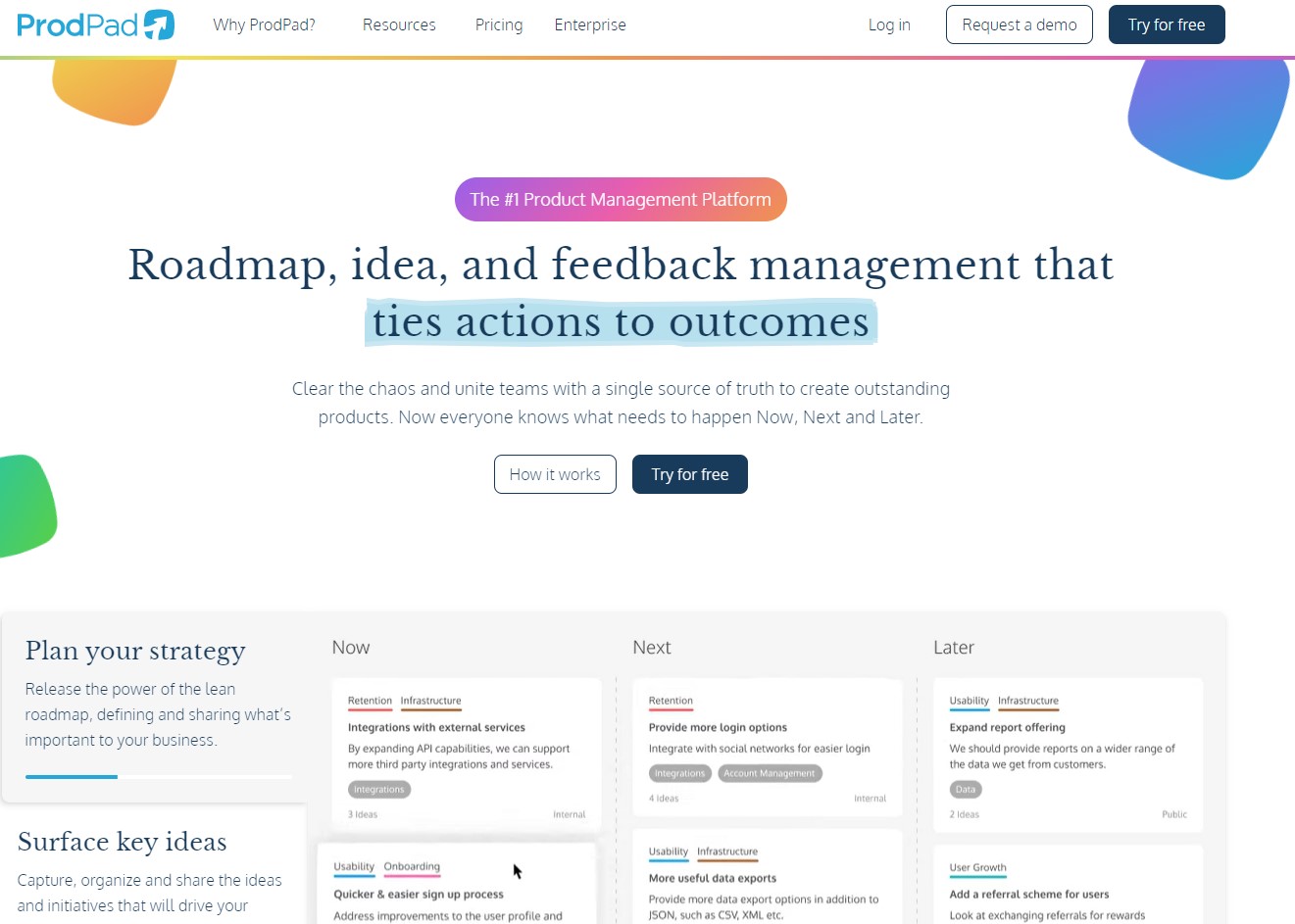
ProPad is one of my favorites among today’s options for the best product lifecycle management software. What makes it great? Its powerful modules and prototyping tools and sorting through customer feedback. An excellent alternative for its user interface that presents us with the latest updates of our team’s work with an attractive design of much more than timelines, but shows you where you are, why, and where you can get to.
Features:
- New release idea manager
- Customer feedback portal
- Design and template a product roadmap.
- It’s project management simplifies the creation of complete product lines.
- Classifies and systematizes information
- Standard integration of email and different communication tools.
- Includes on-premise implementation
Advantages:
- Ideal for organizing and planning new product features based on customer feedback.
- Includes customized product progress reports to learn user behavior.
- The product managers offer drag-and-drop functionality for the uncomplicated design of your product roadmap.
- Integrates with over 25 business tools, such as Jira, Trello, Google Calendars Zapier, and more.
Disadvantages:
- The comment filtering system can be challenging to understand at first.
- The resource management function can be improved.
- The many ideas and user feedback it presents can be a bit confusing.
Pricing:
- Starting price: $75 per month
- Trial period: 7 days
Create outstanding products!
8. Craft.io
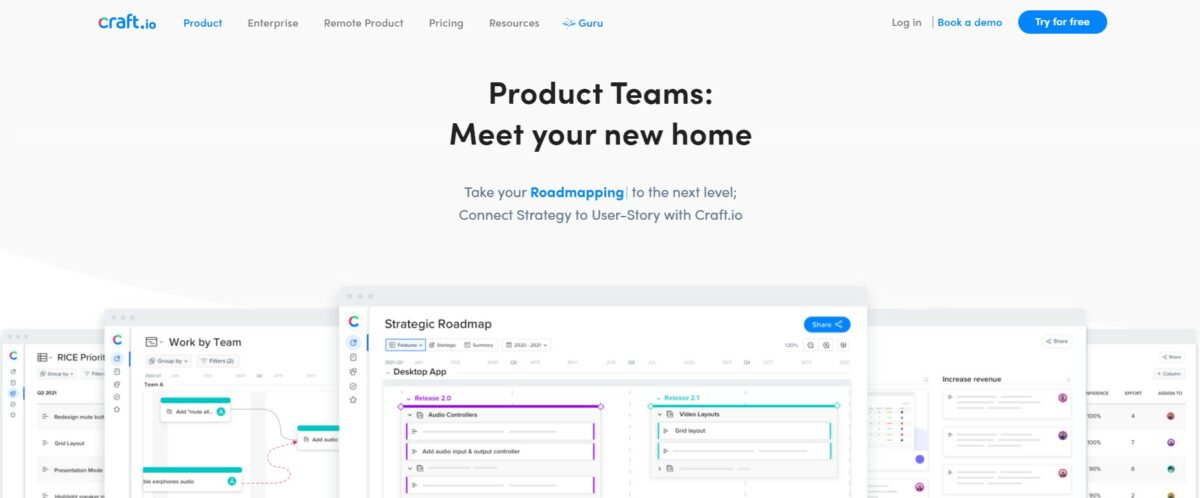
Craft is a product management tool that helps teams from different industries to launch innovative products in the market. So how does it do it? Its cloud-based platform has various modules to simplify your work. First, it facilitates the design of strategies and business plans, it controls the different versions of your product, and I love that it includes a feedback collection module and a chat and messaging module, and a collaboration tool to take work between teams to the next level.
Features:
- Customize workflows
- Track product progress, scrum, and time spent per task.
- Add specific fields and scores based on task priority.
- Create responsive layouts and roadmaps for release planning.
- Tags, comments, and notes to your product stories.
- Summary of the most relevant product lifecycle milestones in Kanban boards.
- Multiple feedback modules gather user research and interactions.
- Integrates with tools like Jira, Dropbox, Google workspace, drive, Zapier, and more.
Advantages:
- You can enter images into your boards.
- Quickly enter and process your ideas, so you don’t miss any details.
- The product managers get support by phone and email.
- Excellent data management solutions as it shows all the information you need in a single window.
Disadvantages:
- Navigation may not be that simple at first.
- Also, it does not have a free version.
Pricing:
- Starting price: $39 per month
- Trail period: 14 days
Design craft ideas!
9. Roadmunk
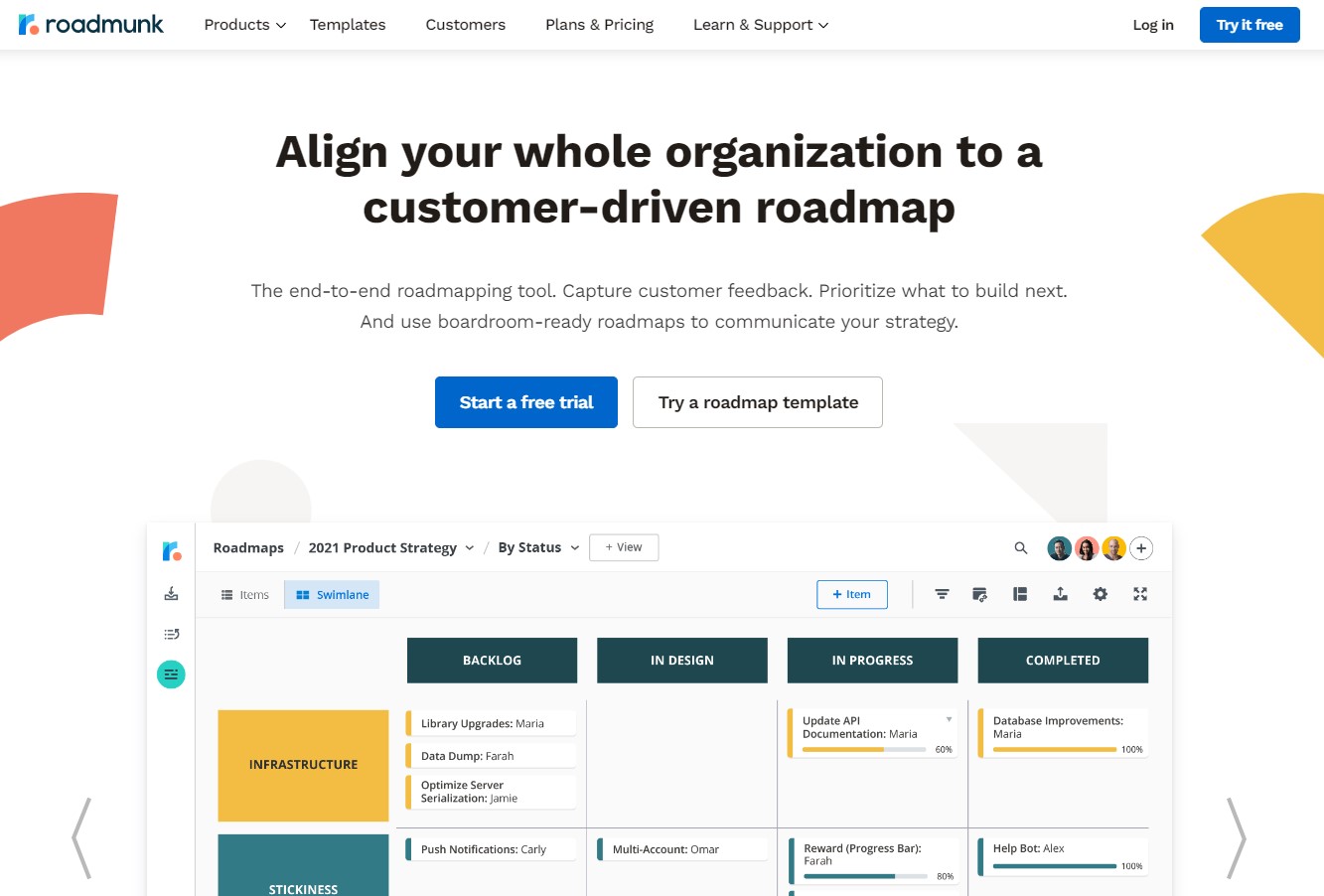
Last but not least in this product management software comparison is Roadmunk, which offers an excellent communication and collaboration tool, and schedule visualization and allows you to create business plans without significant headaches. So why do I recommend it? Because it gives you several options; for example, you can create your own customized product roadmap or choose from the available templates. Also, its data import and export option is handy.
Features:
- Its task management structure activities according to their priority to achieve your goals.
- Create custom data visualization
- You can configure any of the three levels of product management team collaboration.
- Includes annotations and comments so that notes and comments can be added without affecting the project.
- Works with different file formats, pdf, PowerPoint, png, HTML, and more.
Advantages:
- You can create and add schedules with ease.
- Its product manager allows move elements quickly with its drag and drop option.
- Create different views using the same data.
- Your routing has a clean and professional design.
Disadvantages:
- It does not have a free version
- Understanding the tool can be a slow process.
Pricing:
- Starting price: $19 per month
- Trail period: 14 days
What will we build next!
Conclusion
So far, the million-dollar question in these top 9 product management software tools is, which is the right one? Well, define which feature is most important for your business, what is hindering your product teams at the moment, flexibility, visibility, better roadmaps, and user interface, and choose from our list the one that stands out.
You can also enjoy the free samples of each of them to check their usefulness and choose the one that improves your game.
Did you like our recommendations? Which do you think is the right product management software?
I’ll read you in the comments!
Frequently Asked Questions
It is a business activity that directs and organizes each phase of creating a product, i.e., from the idea to the design, implementation, testing, and finally entering the market at a specific price. Its main goal is to meet customers’ needs and what they want to find in the market.
They are the result of combining intelligent business tools such as a product analyzer, a progress tracker, and a roadmap builder. When these software tools are combined, they give your product teams more than just a stack of data; they give you 360° visibility into product lifecycle.
Compiles, organizes, and prioritizes ideas for new product creation.
Synchronize the engineering and product teams to work with the rest of the areas for a more efficient design process.
Ensure that products are created to meet the needs of your target audience.
When selecting your product management tools, I recommend that it should offer some standard features to qualify as an option. At the very least, it should have product analysis software, a built-in roadmap creator, and a progress meter so you can see your progress in real-time.
A fully optimized product manager can increase company profits by 34.2%. So, make sure that the tool you choose supports collaboration between your teams, allows you to examine and keep up to date with customer feedback, create and send surveys and forms, simplify prototyping, create roadmaps, assign tasks and streamline the flow of business information.
The key point to differentiate one from the other is that a project manager aims to accomplish the assignment within the conditions, budget, and schedule. However, a product manager emphasizes creating a final product that meets customer expectations.